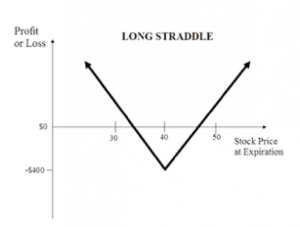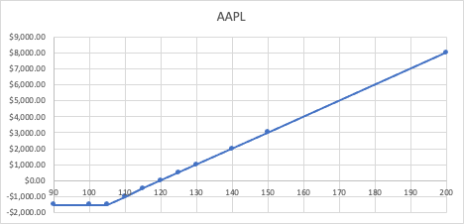One of my favorite components of my role as Chief Analyst of Cabot Options Trader is working with beginner options traders. Very quickly they come to realize that you don’t need to be a rocket scientist to learn to trade options, and with my assistance these subscribers realize that options should be a part of every investor’s trading playbook.
And once I have worked with a beginner options trader at Cabot Options Trader, they can choose to graduate to Cabot Options Trader Pro, where I teach about and execute more advanced strategies such as Long Straddles, Iron Condors and Protective Puts.
Not familiar with those strategies, or how to execute them? Let’s get into each:
Long Straddle
A straddle is a good options strategy to pursue if a trader believes that a stock’s price will move significantly, but is unsure of which direction.
To purchase a straddle, a trader buys a long position in both a call and put with the same strike price and expiration date.
For example:
Stock XYZ is trading at 40
If you were to buy a straddle on stock XYZ, you would simultaneously do the following:
Buy the XYZ December 40 Call
Buy the XYZ December 40 Put
For a total debit of $4
If the stock were to close at 40 on the December expiration, you will lose $4 as both the call and put would expire worthless.
If the stock were to close at 36 or 44, you will break even.
If the stock were to go below 36 or above 44, you will make one dollar for every dollar the stock moves outside of 36 or 44.
Here is a graph depicting the Profit and Loss of a Long Straddle:
Now that we know what buying a straddle means, I want to talk about why this might not be the best strategy for this situation.
In general, the reason is that the market does a great job of pricing options. For example, a slow moving utility stock’s calls and puts are very inexpensive as the stock is unlikely to move dramatically. Conversely, a high-flying growth stock’s options will be much more expensive as the stock is more likely to be volatile.
Similarly, ahead of earnings, or trade talks this week, the options market raises the price of options so that traders can’t buy cheap insurance for a big move.
Only very rarely are options prices extremely mispriced ahead of an event. And for that reason, buying a straddle, in an attempt to play a big market move today/tomorrow, is far from a sure thing.
Iron Condors
While the name Iron Condor may be foreign to you, it’s a risk-defined options strategy that is a great way to create yield. It is a strategy that has a high probability of success, allowing for a modest profit with enough room for error. Also, it’s meant to be a directionally neutral trade.
Essentially, Iron Condors are a strategy that will profit if a stock stays within a defined trading range. And the profits can be substantial.
For example, in August of 2019 salesforce.com (CRM) had just released a strong earnings report, and saw its stock rise from 148 to 152. And because the earnings/major news had passed, I felt that the odds favored CRM trading mostly sideways for the next couple of months.
With that in mind I sold an Iron Condor betting that CRM would not fall from 152 to 130 or below (a 15% decline), or rise to 170 or above (a rise of 11%). If my trade was right, I could make a yield of 21% in two months.
Here is a trade alert I sent to Cabot Options Trader Pro subscribers in late August targeting salesforce.com (CRM):
My Salesforce.com Iron Condor Trade
Iron Condor: Sell the salesforce.com (CRM) October 130/125 Bull Put Spreads and the October 170/175 Bear Call Spreads for $0.87 or more.
Option volatility remains high in the market due to the recent wild swings for the indexes. Today I am going to execute an Iron Condor in salesforce.com (CRM), which just recently reported strong earnings, that will sell this elevated volatility.
To execute this trade, you need to:
Sell to Open the October 130 Put,
Buy to Open the October 125 Put,
Sell to Open the October 170 Call, and
Buy to Open the October 175 Call
The most you can make on this trade is the premium collected, or $87 per iron condor (a yield of 21% in two months’ time) if CRM were to close between 130 and 170 on October expiration.
The most you can lose on this trade is $413 per Iron Condor if CRM were to close below 125 or above 175 on October expiration.
Essentially we are selling insurance that CRM will not move lower by 15% or higher by 11%.
So how did that trade work out?
A couple weeks later we closed the Iron Condor for a profit of 12.75%.
But why did we not collect the full 21% that I had hoped to gain?
The answer is that my Options Scanner had started to pick up on unusual call buying targeting a big move higher in CRM. And because of that, I felt that the 12.75% profit was enough, and then flipped into a CRM call buy!
Protective Puts
A protective put is used when a trader is bullish on a stock he is buying or already owns, but is wary of the stock’s short-term future. It is used as a means to protect unrealized gains, while giving the trader continued upside potential.
For example, theoretically in September of last year I wanted to buy 100 shares of Apple (AAPL) at 110. This is how I would have implemented the strategy.
First, I would buy my 100 shares.
Second, I would Buy to Open one AAPL January 105 Put for $10.
The total cash outlay for the put is actually $1,000 because each put represents 100 shares. That $1,000 is the insurance policy I took out on my stock position, and will protect my 100 shares if AAPL were to take a much bigger fall. Here’s a graph of the stock position combined with the put purchased:
In essence, I would have bought an insurance policy that would protect me for four months from a big fall.
If AAPL fell, my losses were stopped at 105, which is the strike price of the put that I bought.
At 105 or below, I have the right, but not obligation, to exercise my put, which would take me out of my AAPL stock position. I would likely exercise this right to sell my stock at 105 if AAPL had fallen precipitously lower.
However, to the upside, my potential gains are unlimited!
While I don’t love paying for insurance/puts, given the recent dramatic drop in countless market leaders, this strategy is a great way to protect my stock holding while maintaining upside potential.


